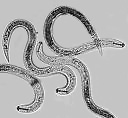 Before about 1990,
foliar nematodes were not considered a problem of
hostas. Then, over the next decade or so, people
began to notice the browning of the space between
the leaf veins as the growing season progressed.
Upon closer examination in the lab, it was
discovered that a small roundworm (i.e. a nematode)
was causing this discoloration.
Before about 1990,
foliar nematodes were not considered a problem of
hostas. Then, over the next decade or so, people
began to notice the browning of the space between
the leaf veins as the growing season progressed.
Upon closer examination in the lab, it was
discovered that a small roundworm (i.e. a nematode)
was causing this discoloration.
One of the problems
in identifying this pest is that it often looks
similar to normal browning of leaves that occurs in
the fall. Unless a person was very familiar with the
problem they might easily overlook it.
Foliar nematodes are
rather rare. Most types of this plant pest infect
roots and are known as root knot nematodes. The
foliar types go up into the leaves to feed and then
move back down into the crown of the plant to
overwinter. The veins of the leave form a type of
barrier so that the activity may be between one set
of veins and might not show in the next interveinal
area.
What do these critter
do to the
hosta? Well it appears that they do two
things. First, they make the plants less thrifty and
cause them to loose vigor. The other impact is that
they make the foliage look bad starting in about
August.
Control of the
nematodes once they are in your garden is difficult.
They do not seem to infect all types of hostas and
some cultivars are much more susceptible than others.
For specimen plants, some people have suggested the
use of a hot water bath that would kill the
nematodes but not damage the plants crown. Chemicals
called nematicides may work but they must be applied
by a licensed pesticide applicator and are generally
not available to the home gardener.
For now, exclusion
seems to be the most effective approach. Purchase
plants from only reputable nurseries who are aware
of the problem and who take measures to exclude this
pest from their stock. Be careful when "swapping"
plants with other hosta collectors. Finally, if you
find nematodes (and are absolutely sure by a lab
test) eliminate the infested plants from your
garden. Be sure to dispose of them away from the
garden and not in the compost pile.
The American Hosta
Society is continuing to investigate this problem in
cooperation with university researchers.



